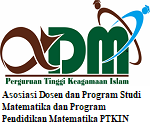Ideal Data to Determine Accurate Fajr Time
DOI:
https://doi.org/10.15642/mantik.2022.8.1.28-35Keywords:
Dawn light, Fair time, Sky quality meterAbstract
Early fajr time research was carried out by various parties with various techniques, one of which was using a sky quality meter (SQM) photometric tool. Observational data from various regions that have varying night levels result in a varying early fajr time as well. By paying attention to the effect of sky quality represented by the night level at the observation location, this research wants to answer whether the 20 mpsas night level limit is ideal data by looking at the correlation coefficient between night level and the turning point solution. From 1068 data with varying night levels, the correlation coefficient ( ) between the night level and the turning point solution is 0,42 which means there is an effect, while for data with a minimum night level of 20mpsas the correlation coefficient is 0,07 which means there is no influence. Based on the results of the analysis, the night level of 20mpsas can be the minimum limit for conducting an ideal early fajr time research. From 241 ideal observation data from 6 LAPAN observation stations, early fajr time presents when the Sun's elevation angle is -16,51°. Early fajr time is also the beginning of subuh prayer time, with its standard used in Indonesia, which is -20° or 3,49° different from the analysis results, if it is converted there is a difference of 13 minutes 57 seconds.
Downloads
References
J. B. Kaler, The ever-changing sky: a guide to the celestial sphere, 1st ed. Cambridge: Cambridge University Press, 2002, p. 495.
M. Maskufa, D. R. Munazat, A. Damanhuri, and A. Abd. Shomad, “The Implication of Sky Quality Meter Technology in Observing the Dawn To Determine Subh Prayer Time,” presented at the Proceedings of the 2nd International Conference on Quran and Hadith Studies Information Technology and Media in Conjunction with the 1st International Conference on Islam, Science and Technology, ICONQUHAS & ICONIST, Bandung, October 2-4, 2018, Indonesia, 2020. doi: 10.4108/eai.2-10-2018.2295598.
A. H. Hassan, I. A. Issa, M. Mousa, and Y. A. Abdel-Hadi, “NRIAG Journal of Astronomy and Geophysics Naked eye determination of the dawn for Sinai and Assiut of Egypt Naked eye determination of the dawn for Sinai and Assiut of Egypt,” 2019, doi: 10.1016/j.nrjag.2016.02.001.
K. Bahali, A. L. Samian, N. Muslim, and N. S. A. Hamid, “Measuring the sun depression angle of dawn with a DSLR camera,” Sains Malays., vol. 47, no. 11, pp. 2877–2885, 2018, doi: 10.17576/jsm-2018-4711-31.
K. Bahali, A. L. Samian, N. Muslim, N. Shazana, and A. Hamid, “Article ID: IJMET_10_02_119 Cite this Article; Kassim Bahali, Abdul Latif Nazri Muslim And Samian Nurul Shazana Abdul Hamid Measuring Luminance and Sun Depression Angle of,” Dawn Int. J. Mech. Eng. Technol. IJMET, vol. 10, no. 2, pp. 1136–1150, 2019.
L. A. Harijadi Noor, D. Herdiwijaya, and A. Wibowo, “Measurement of the Night Sky Brightness in e-Maya Observatory,” J. Phys. Conf. Ser., vol. 1245, no. 1, 2019, doi: 10.1088/1742-6596/1245/1/012031.
S. A. M. Nor and M. Z. Zainuddin, “Sky Brightness for Determination of Fajr and Isha Prayer by Using Sky Quality Meter,” Int. J. Sci. Eng. Res., vol. 3, no. 8, pp. 1–3, 2012.
T. Saksono and M. A. Fulazzaky, “Predicting the accurate period of true dawn using a third-degree polynomial model,” NRIAG J. Astron. Geophys., vol. 9, no. 1, pp. 238–244, 2020, doi: 10.1080/20909977.2020.1738106.
M. Aubé, “Physical behaviour of anthropogenic light propagation into the nocturnal environment,” Philos. Trans. R. Soc. B Biol. Sci., 2015, doi: 10.1098/rstb.2014.0117.
A. S. de Miguel, M. Aubé, J. Zamorano, M. Kocifaj, J. Roby, and C. Tapia, “Sky quality meter measurements in a colour-changing world,” Mon. Not. R. Astron. Soc., 2017, doi: 10.1093/mnras/stx145.
X. Ges, S. Bará, M. García-Gil, J. Zamorano, S. J. Ribas, and E. Masana, “Light pollution offshore: Zenithal sky glow measurements in the mediterranean coastal waters,” J. Quant. Spectrosc. Radiat. Transf., 2018, doi: 10.1016/j.jqsrt.2018.02.014.
A. Jechow, F. Hölker, Z. Kolláth, M. O. Gessner, and C. C. M. Kyba, “Evaluating the summer night sky brightness at a research field site on Lake Stechlin in northeastern Germany,” J. Quant. Spectrosc. Radiat. Transf., 2015, doi: 10.1016/j.jqsrt.2016.02.005.
E. P. Arumaningtyas, M. Raharto, and D. Herdiwijaya, “Morning Twilight Measured at Bandung and Jombang,” 2012, pp. 29–31. doi: 10.1063/1.4730680.
A. Hänel et al., “Measuring night sky brightness: methods and challenges,” J. Quant. Spectrosc. Radiat. Transf., vol. 205, 2018, doi: 10.1016/j.jqsrt.2017.09.008.
D. Herdiwijaya, “On the beginning of the morning twilight based on sky brightness measurements,” J. Phys. Conf. Ser., vol. 1523, no. 1, 2020, doi: 10.1088/1742-6596/1523/1/012007.
J. Bortle, “Introducing the Bortle dark-sky scale,” Sky Telesc., no. February, pp. 126–130, 2001.
B. S. A. Club, “Bortle Dark-Sky Scale”, [Online]. Available: http://www.bigskyastroclub.org/lp_bortle.html
A. Crumey, “Human contrast threshold and astronomical visibility,” vol. 2619, no. 2014, pp. 2600–2619, 2018, doi: 10.1093/mnras/stu992.
A. Damanhuri, Pengamatan dan Penelitian Awal Waktu Subuh: Semua Bisa Melakukannya, I., no. 9. Surabaya: Nizamia Learning Center, 2020, p. 122.
S. Excel, “Memuat Add-in Solver di Excel - Dukungan Office”, [Online]. Available: https://support.office.com/id-id/article/memuat-add-in-solver-di-excel-612926fc-d53b-46b4-872c-e24772f078ca
Microsoft, “Menetapkan dan menyelesaikan masalah dengan menggunakan Solver - Dukungan Office”, [Online]. Available: https://support.office.com/id-id/article/menetapkan-dan-menyelesaikan-masalah-dengan-menggunakan-solver-5d1a388f-079d-43ac-a7eb-f63e45925040
M. Abdurrahman, S. A. Muhidin, and A. Somantri, Dasar-Dasar Metode Statistik Untuk Penelitian. Bandung: Penerbit Pustaka Setia, 2017, p. 352.
J. Bennie, T. W. Davies, R. Inger, and K. J. Gaston, “Mapping artificial lightscapes for ecological studies,” Methods Ecol. Evol., 2014, doi: 10.1111/2041-210X.12182.
F. Bilki, M. G. Zadnik, J. D. Biggs, and T. Fouch, “Measuring and mapping the night sky brightness of Perth , Western Australia,” vol. 1464, no. April, pp. 1450–1464, 2018, doi: 10.1111/j.1365-2966.2012.20416.x.
A. G. Admiranto, R. Priyatikanto, S. Maryam, Ellyyani, and N. Suryana, “Preliminary report of light pollution in indonesia based on sky quality observation,” J. Phys. Conf. Ser., vol. 1231, no. 1, 2019, doi: 10.1088/1742-6596/1231/1/012017.
A. Bertolo, R. Binotto, S. Ortolani, and S. Sapienza, “Measurements of night sky brightness in the Veneto Region of Italy: Sky quality meter network results and differential photometry by digital single lens reflex,” J. Imaging, vol. 5, no. 5, 2019, doi: 10.3390/jimaging5050056.
H. Cui, J. Shen, Y. Huang, X. Shen, C. W. So, and C. S. J. Pun, “Night sky brightness monitoring network in Wuxi, China,” J. Quant. Spectrosc. Radiat. Transf., vol. 258, pp. 107219–107219, 2021, doi: 10.1016/j.jqsrt.2020.107219.
Y. Katz and N. Levin, “Quantifying urban light pollution - A comparison between field measurements and EROS-B imagery,” Remote Sens. Environ., 2016, doi: 10.1016/j.rse.2016.02.017.
J. Puschnig, A. Schwope, T. Posch, and R. Schwarz, “The night sky brightness at Potsdam-Babelsberg including overcast and moonlit conditions,” J. Quant. Spectrosc. Radiat. Transf., vol. 139, pp. 76–81, 2014, doi: 10.1016/j.jqsrt.2013.12.011.
D. Gil, M. Honarmand, J. Pascual, E. Pérez-Mena, and C. Macías Garcia, “Birds living near airports advance their dawn chorus and reduce overlap with aircraft noise,” Behav. Ecol., 2015, doi: 10.1093/beheco/aru207.
D. Klem Jr, D. C. Keck, K. L. Marty, A. J. Miller Ball, E. E. Niciu, and C. T. Platt, “Effects of Window Angling, Feeder Placement, and Scavengers on Avian Mortality at Plate Glass,” Wilson Bull., vol. 116, no. 1, pp. 69–73, 2004, doi: 10.1676/0043-5643(2004)116[0069:EOWAFP]2.0.CO;2.
N. F. Ngadiman, N. N. M. Shariff, and Z. S. Hamidi, “Sensor Technology for Night Sky Brightness Studies in Malaysia,” Int. J. Recent Technol. Eng. IJRTE, no. 6, pp. 5–5, 2019, doi: 10.35940/ijrte.D9721.038620.
K. Siregar, A. Ishak, and M. Esterlita, “Distribution Testing on the Average Room Occupancy Rate of Hotels by Province in 2013-2017,” IOP Conf. Ser. Mater. Sci. Eng., vol. 1003, no. 1, 2020, doi: 10.1088/1757-899X/1003/1/012107.
R. E. Walpole, Raymond H. Myers, Sharon L. Myers, and Keying Ye, Probability & Statistics for Engineers & Scienticts, IX. Boston: Pearson Education, 2012, p. 812.
T. Williams et al., “gnuplot 5.2 An Interactive Plotting Program,” vol. 8, no. December, 2019, [Online]. Available: http://www.gnuplot.info/docs_5.2/Gnuplot_5.2.pdf
Downloads
Published
How to Cite
Issue
Section
License
Copyright (c) 2022 Adi Damanhuri, Akhmad Mukarram

This work is licensed under a Creative Commons Attribution-NonCommercial-ShareAlike 4.0 International License.
- Authors retain copyright and grant the journal right of first publication with the work simultaneously licensed under a Creative Commons License that allows others to share the work with an acknowledgment of the work's authorship and initial publication in this journal.
- Authors are able to enter into separate, additional contractual arrangements for the non-exclusive distribution of the journal's published version of the work (e.g., post it to an institutional repository or publish it in a book), with an acknowledgment of its initial publication in this journal.
- Authors are permitted and encouraged to post their work online (e.g., in institutional repositories or on their website) prior to and during the submission process, as it can lead to productive exchanges, as well as earlier and greater citation of published work







.png)




